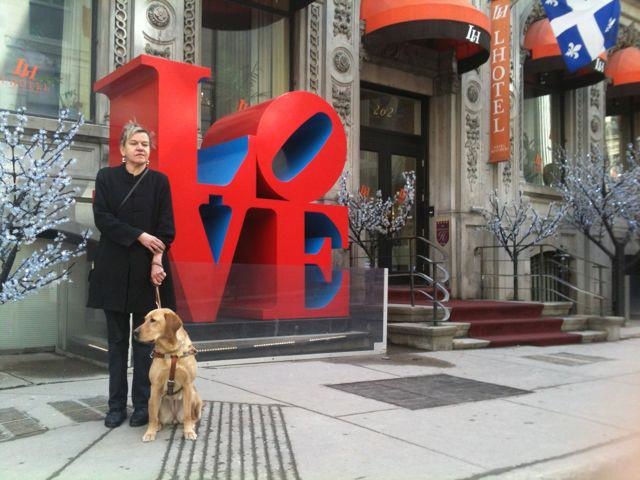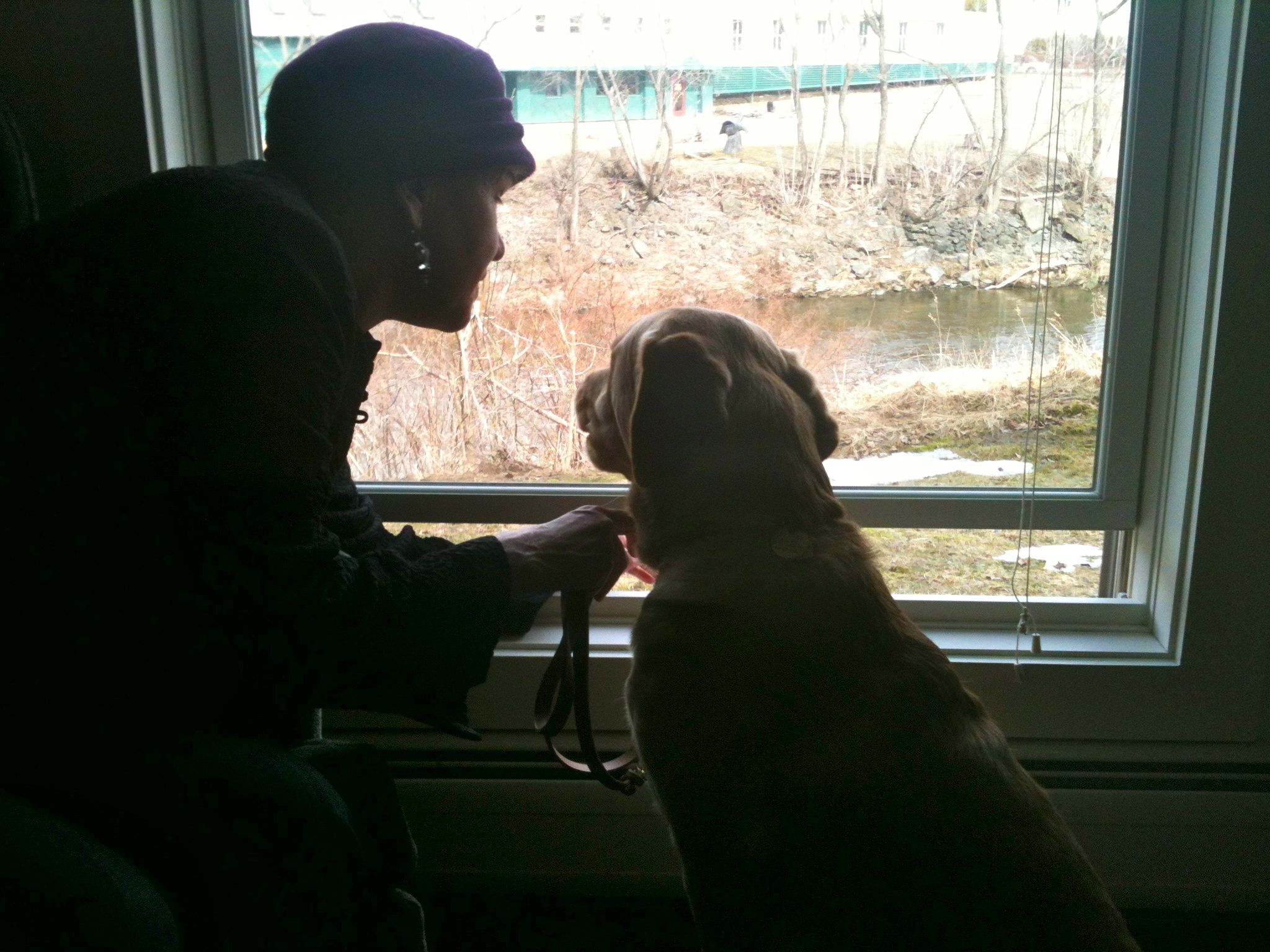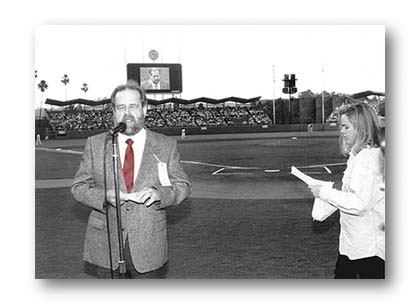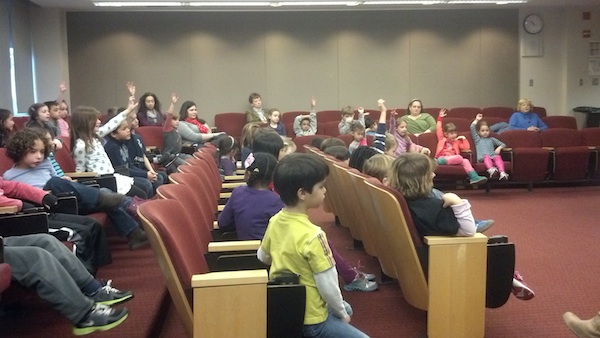So, Beth and I were in Montreal before we dropped her in Vermont. Everything about our Quebec weekend was fabulous. Fantastic food, charming people–and some great artwork–in our hotel! But more on that later. First, a dispatch about Beth’s first week in Vermont.

Beth and Whitney outside our hotel–Lhotel–in Montreal. The place is packed with the owner’s art collection.
On Sunday we woke up in
Lhotel, went downstairs for one more sublime breakfast of sublime croissant and sublime coffee–not to mention meats and cheeses. Then it was off to…Hertz. Somehow, nothing kills a croissant buzz like a rental car. But hey, we got a nice Jetta, and we headed to Johnson, Vermont.
Beth and I had already talked about dropoff day — it was a source of quiet dread for both of us. Now, Beth getting an NEA fellowship to work on her writing was a terrific thing. The Vermont Studio Center — by multiple accounts of friends who’d spent time there — is a terrific place. Still, the dread — well beyond the natural trepidation about a month-long separation.
We figured out that it traces back almost 28 years. That’s when I dropped off Beth at what was then called the Illinois Visually Handicapped Institute — destined to be renamed Braille Jail by Beth after an up-and-down stay of nearly three months. The application process to get into IVHI had been a classic paper chase — with doctor’s reports, waivers, and endless mortgage-financing-style requests for more and more documentation.
We’d been married a year and already had spent a good portion of it apart from one another. Beth’s surgeries and hospitalizations and followup visits were in Chicago — but we lived in Urbana. So I’d see her on weekends and head back to Urbana and back to work, always hoping for the best. After the doctor said Beth would not see again, she came home. It was difficult and awkward, but at least we were together. And I wasn’t trusting her care to strangers.
So, by the fall of 1985, even though we both knew Beth needed to spend time at IVHI, the last thing we wanted was for her to go away for several months.
Still, we thought, it was worth it: Beth would learn Braille. And orientation and mobility skills (using a white cane to navigate). And the romantically labeled Activities of Daily living (cooking, cleaning, daily grind stuff). And, importantly, she’d learn to measure out and give insulin injections for herself using some adaptive tools and techniques. I’d been preparing her shots since she came home.
We moved Beth into her dorm room, we took a guided tour, we met the director. I felt like I was dropping her off at college. Except it wasn’t anything like college. It was something she had to do because she was blind. It didn’t help that though that neighborhood has changed radically for the better since 1985, back then, it was treacherous. And the place felt a little prison-like.
It was not a happy time. We said teary goodbyes, and I drove south to our apartment in Champaign. Telling myself that it was silly to worry and that this was important, all the way down the straight, flat and lonely I-57.
Well.
Not long after I got home, the phone rang. It was Beth. She had a shaky voice. I asked her what was wrong. “I’m at Cook County hospital,” she said. “WHAT!?” I boomed over the phone. I collected myself. Until Beth learned how to do her own injections, a nurse would have to do it. Except IVHI had forgotten that. And no nurse was on duty. She asked staff who were there to simply measure an injection, but they said the rules said they couldn’t do that.
So, of course, the reasonable next step was going to the Cook County Hospital emergency room, where Beth waited in a hallway for hours to receive her insulin injection. It was an awful start to an awful stay that was rife with bureaucratic snafus and delays. For example, we’d obtained a doctor’s statement that Beth was fit enough for the occupation and mobility training — which could be strenuous. But that paperwork got lost. We got replacements, but it set off a dominoes-from-hell chain reaction that prevented Beth from getting mobility training for more than a month. She really was something of a prisoner.
All of this came from an entity that was supposed to be helping. It was the last thing Beth needed at that point. I didn’t much care for it, either.
And so, whether it’s been going away to get her dogs or — going to Vermont — we are both haunted by those dark times whenever she’s headed off for an extended period of time.

Whitney likes the view outside Beth’s studio.
At the Vermont Studio Center, I helped her get situated in her room — and her cute little studio space, which happens to be right beside a lovely little stream, which runs down from lovely mountains. Nothing fancy, but, well, lovely. Still, Vermont is not know for right angles or a grid road system — which present challenges to Beth and Whitney. And we both knew it would take her days before she was confident getting from her dorm to her studio to the dining hall and back.
But, we both know she would. In a very short time on Sunday afternoon, we met terrific people — staff and fellow students–who had already been extremely helpful. And so, though it was sad to part, I felt good by the time I got home Sunday night.
And then, Monday, I got a call. “I’ve had an eventful day,” Beth said. And she had. She slept fitfully her first night. Her elbow hurt. She had a fever. One of the Vermont staff looked at her arm and said it looked bad, and wisely took her to the nearest emergency room. There, they suspected a staph infection. They did an incision — and an MRI — to determine that the infection had not gone deep into her joint and muscle tissue. Still, because of the threat of superbugs, they started her on a cocktail of antibiotics, including some pretty strong stuff.
Luckily, cultures came back that indicated it wasn’t as serious as it might have been. And the antibiotics did their job. And today, she called to say that after two nights in the hospital, she was back in her studio. Writing. With Whitney at her feet. Next to that beautiful little stream. In that beautiful little town. She’ll get visits from a nurse for 10 days, but she’s in great spirits. She says the food is terrific — the Studio has a staff chef!
Whew. She’s back. She’s fine.
And just maybe, the ghost of Braille Jail is gone. For good.




